Research Project on Nosocomial Infection Among Staff Nurses (NRS 621)
VerifiedAdded on 2023/04/06
|13
|3322
|230
Report
AI Summary
This research project, conducted for the Evidence-based Practices course (NRS 621) at Majmaah University, investigates the knowledge and awareness of nosocomial infections among staff nurses in Saudi Arabia. The project includes a literature review, exploring the background of nosocomial infections, methodology, and findings from selected research articles. The methodology section details a systematic review process, outlining inclusion and exclusion criteria for relevant studies. The report analyzes articles focusing on the knowledge and practice levels of nurses regarding healthcare-associated infections, assessment of knowledge about standard precautions and nosocomial infections, and related factors. Findings from these studies highlight the importance of education and awareness programs to improve infection control practices and patient safety. The project adheres to APA format and addresses key aspects such as research questions, study design, and data analysis methods.

----------------------------------------------------------------------------------------------------
-
INSTRUCTIONS FOR EXAMINATION
1. Write your Name and University Register Number clearly in the space given.
2. Use only blue or black dry pens for writing the answers. Use colors and Pencils for Diagrams.
3. The possession of books, notes, papers, any printed materials inside the examination hall are strictly prohibited,
and students who are violating the rules will be dealt by disciplinary committee, under the regulations of
Majmaah University.
4. Students are not allowed to leave the examination hall before 30 minutes from the commencement of
Examination.
Consistency with Program Outcomes
5. Psychomotor4. Com., IT & Num.3. I.P Skills &
Res.
2. Cognitive Skills1. Knowledge
5.25.14.34.24.13.23.12.42.32.22.11.41.31.21.1
Marks:
Project CLO’s KPI's Marks Verification Name & Signature
Research
Project
Course Instructor
Dr. Cris S. Adolfo
Course Coordinator
Dr. Jinu Rajan
Assessment Unit
Final Mark
Total 30
Kingdom of Saudi Arabia
Ministry of Higher Education
Majmaah University
College of Applied Medical Sciences (CAMS)
Nursing Dept. (NRS)
Student name: .................................................................................................. I.D number:
Course Name: Evidence-based Practices: Practical Course Code: NRS 621 Section Number: 1550
Date: …… / …… /……… H …… / …… /……… G Duration: …… Hours Total of pages: ….…
RESEARCH PROJECT
(2nd Semester 1439-1440)
----------------------------------------------------------------------------------------------------
-
INSTRUCTIONS FOR EXAMINATION
1. Write your Name and University Register Number clearly in the space given.
2. Use only blue or black dry pens for writing the answers. Use colors and Pencils for Diagrams.
3. The possession of books, notes, papers, any printed materials inside the examination hall are strictly prohibited,
and students who are violating the rules will be dealt by disciplinary committee, under the regulations of
Majmaah University.
4. Students are not allowed to leave the examination hall before 30 minutes from the commencement of
Examination.
Consistency with Program Outcomes
5. Psychomotor4. Com., IT & Num.3. I.P Skills &
Res.
2. Cognitive Skills1. Knowledge
5.25.14.34.24.13.23.12.42.32.22.11.41.31.21.1
Marks:
Project CLO’s KPI's Marks Verification Name & Signature
Research
Project
Course Instructor
Dr. Cris S. Adolfo
Course Coordinator
Dr. Jinu Rajan
Assessment Unit
Final Mark
Total 30
Kingdom of Saudi Arabia
Ministry of Higher Education
Majmaah University
College of Applied Medical Sciences (CAMS)
Nursing Dept. (NRS)
Student name: .................................................................................................. I.D number:
Course Name: Evidence-based Practices: Practical Course Code: NRS 621 Section Number: 1550
Date: …… / …… /……… H …… / …… /……… G Duration: …… Hours Total of pages: ….…
RESEARCH PROJECT
(2nd Semester 1439-1440)
Paraphrase This Document
Need a fresh take? Get an instant paraphrase of this document with our AI Paraphraser
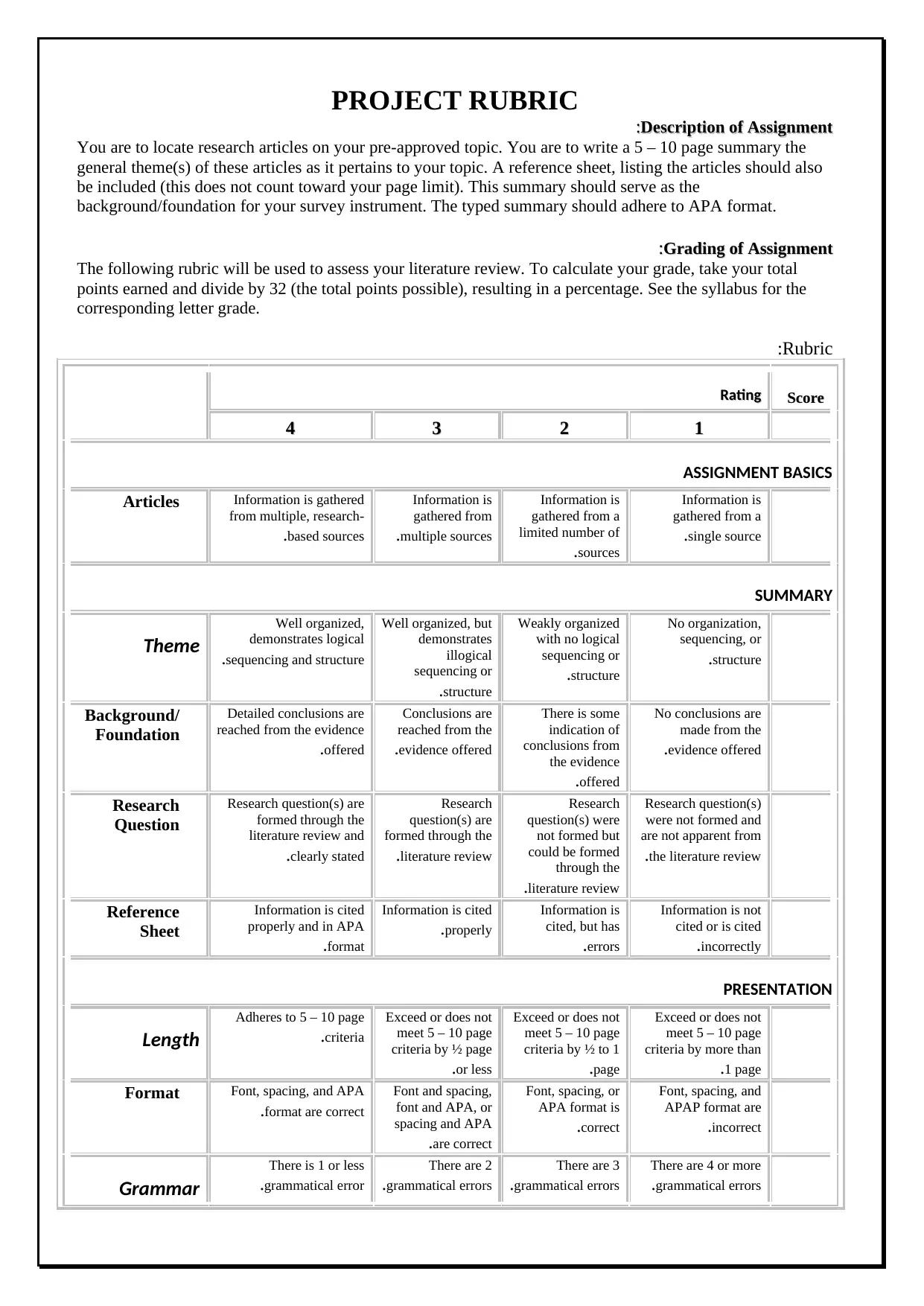
PROJECT RUBRIC Description of AssignmentDescription of Assignment::
You are to locate research articles on your pre-approved topic. You are to write a 5 – 10 page summary the
general theme(s) of these articles as it pertains to your topic. A reference sheet, listing the articles should also
be included (this does not count toward your page limit). This summary should serve as the
background/foundation for your survey instrument. The typed summary should adhere to APA format.
Grading of AssignmentGrading of Assignment::
The following rubric will be used to assess your literature review. To calculate your grade, take your total
points earned and divide by 32 (the total points possible), resulting in a percentage. See the syllabus for the
corresponding letter grade.
Rubric:
RatingRating ScoreScore
44 33 22 11
ASSIGNMENT BASICS
Articles Information is gathered
from multiple, research-
based sources.
Information is
gathered from
multiple sources.
Information is
gathered from a
limited number of
sources.
Information is
gathered from a
single source.
SUMMARY
Theme
Well organized,
demonstrates logical
sequencing and structure.
Well organized, but
demonstrates
illogical
sequencing or
structure.
Weakly organized
with no logical
sequencing or
structure.
No organization,
sequencing, or
structure.
Background/
Foundation
Detailed conclusions are
reached from the evidence
offered.
Conclusions are
reached from the
evidence offered.
There is some
indication of
conclusions from
the evidence
offered.
No conclusions are
made from the
evidence offered.
Research
Question
Research question(s) are
formed through the
literature review and
clearly stated.
Research
question(s) are
formed through the
literature review.
Research
question(s) were
not formed but
could be formed
through the
literature review.
Research question(s)
were not formed and
are not apparent from
the literature review.
Reference
Sheet
Information is cited
properly and in APA
format.
Information is cited
properly.
Information is
cited, but has
errors.
Information is not
cited or is cited
incorrectly.
PRESENTATION
Length
Adheres to 5 – 10 page
criteria.
Exceed or does not
meet 5 – 10 page
criteria by ½ page
or less.
Exceed or does not
meet 5 – 10 page
criteria by ½ to 1
page.
Exceed or does not
meet 5 – 10 page
criteria by more than
1 page.
Format Font, spacing, and APA
format are correct.
Font and spacing,
font and APA, or
spacing and APA
are correct.
Font, spacing, or
APA format is
correct.
Font, spacing, and
APAP format are
incorrect.
Grammar
There is 1 or less
grammatical error.
There are 2
grammatical errors.
There are 3
grammatical errors.
There are 4 or more
grammatical errors.
You are to locate research articles on your pre-approved topic. You are to write a 5 – 10 page summary the
general theme(s) of these articles as it pertains to your topic. A reference sheet, listing the articles should also
be included (this does not count toward your page limit). This summary should serve as the
background/foundation for your survey instrument. The typed summary should adhere to APA format.
Grading of AssignmentGrading of Assignment::
The following rubric will be used to assess your literature review. To calculate your grade, take your total
points earned and divide by 32 (the total points possible), resulting in a percentage. See the syllabus for the
corresponding letter grade.
Rubric:
RatingRating ScoreScore
44 33 22 11
ASSIGNMENT BASICS
Articles Information is gathered
from multiple, research-
based sources.
Information is
gathered from
multiple sources.
Information is
gathered from a
limited number of
sources.
Information is
gathered from a
single source.
SUMMARY
Theme
Well organized,
demonstrates logical
sequencing and structure.
Well organized, but
demonstrates
illogical
sequencing or
structure.
Weakly organized
with no logical
sequencing or
structure.
No organization,
sequencing, or
structure.
Background/
Foundation
Detailed conclusions are
reached from the evidence
offered.
Conclusions are
reached from the
evidence offered.
There is some
indication of
conclusions from
the evidence
offered.
No conclusions are
made from the
evidence offered.
Research
Question
Research question(s) are
formed through the
literature review and
clearly stated.
Research
question(s) are
formed through the
literature review.
Research
question(s) were
not formed but
could be formed
through the
literature review.
Research question(s)
were not formed and
are not apparent from
the literature review.
Reference
Sheet
Information is cited
properly and in APA
format.
Information is cited
properly.
Information is
cited, but has
errors.
Information is not
cited or is cited
incorrectly.
PRESENTATION
Length
Adheres to 5 – 10 page
criteria.
Exceed or does not
meet 5 – 10 page
criteria by ½ page
or less.
Exceed or does not
meet 5 – 10 page
criteria by ½ to 1
page.
Exceed or does not
meet 5 – 10 page
criteria by more than
1 page.
Format Font, spacing, and APA
format are correct.
Font and spacing,
font and APA, or
spacing and APA
are correct.
Font, spacing, or
APA format is
correct.
Font, spacing, and
APAP format are
incorrect.
Grammar
There is 1 or less
grammatical error.
There are 2
grammatical errors.
There are 3
grammatical errors.
There are 4 or more
grammatical errors.
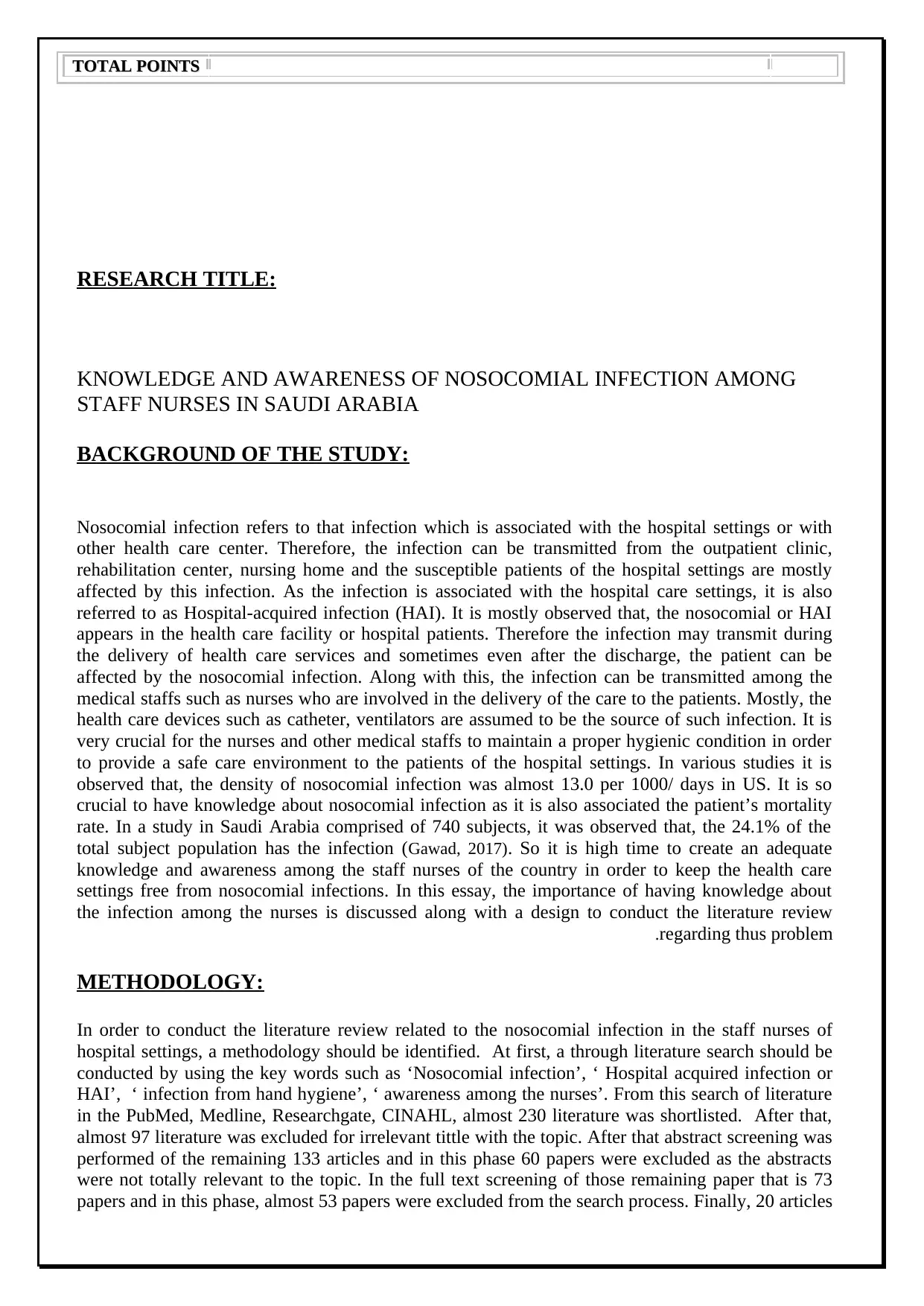
TOTAL POINTSTOTAL POINTS
RESEARCH TITLE:
KNOWLEDGE AND AWARENESS OF NOSOCOMIAL INFECTION AMONG
STAFF NURSES IN SAUDI ARABIA
BACKGROUND OF THE STUDY:
Nosocomial infection refers to that infection which is associated with the hospital settings or with
other health care center. Therefore, the infection can be transmitted from the outpatient clinic,
rehabilitation center, nursing home and the susceptible patients of the hospital settings are mostly
affected by this infection. As the infection is associated with the hospital care settings, it is also
referred to as Hospital-acquired infection (HAI). It is mostly observed that, the nosocomial or HAI
appears in the health care facility or hospital patients. Therefore the infection may transmit during
the delivery of health care services and sometimes even after the discharge, the patient can be
affected by the nosocomial infection. Along with this, the infection can be transmitted among the
medical staffs such as nurses who are involved in the delivery of the care to the patients. Mostly, the
health care devices such as catheter, ventilators are assumed to be the source of such infection. It is
very crucial for the nurses and other medical staffs to maintain a proper hygienic condition in order
to provide a safe care environment to the patients of the hospital settings. In various studies it is
observed that, the density of nosocomial infection was almost 13.0 per 1000/ days in US. It is so
crucial to have knowledge about nosocomial infection as it is also associated the patient’s mortality
rate. In a study in Saudi Arabia comprised of 740 subjects, it was observed that, the 24.1% of the
total subject population has the infection (Gawad, 2017). So it is high time to create an adequate
knowledge and awareness among the staff nurses of the country in order to keep the health care
settings free from nosocomial infections. In this essay, the importance of having knowledge about
the infection among the nurses is discussed along with a design to conduct the literature review
regarding thus problem.
METHODOLOGY:
In order to conduct the literature review related to the nosocomial infection in the staff nurses of
hospital settings, a methodology should be identified. At first, a through literature search should be
conducted by using the key words such as ‘Nosocomial infection’, ‘ Hospital acquired infection or
HAI’, ‘ infection from hand hygiene’, ‘ awareness among the nurses’. From this search of literature
in the PubMed, Medline, Researchgate, CINAHL, almost 230 literature was shortlisted. After that,
almost 97 literature was excluded for irrelevant tittle with the topic. After that abstract screening was
performed of the remaining 133 articles and in this phase 60 papers were excluded as the abstracts
were not totally relevant to the topic. In the full text screening of those remaining paper that is 73
papers and in this phase, almost 53 papers were excluded from the search process. Finally, 20 articles
RESEARCH TITLE:
KNOWLEDGE AND AWARENESS OF NOSOCOMIAL INFECTION AMONG
STAFF NURSES IN SAUDI ARABIA
BACKGROUND OF THE STUDY:
Nosocomial infection refers to that infection which is associated with the hospital settings or with
other health care center. Therefore, the infection can be transmitted from the outpatient clinic,
rehabilitation center, nursing home and the susceptible patients of the hospital settings are mostly
affected by this infection. As the infection is associated with the hospital care settings, it is also
referred to as Hospital-acquired infection (HAI). It is mostly observed that, the nosocomial or HAI
appears in the health care facility or hospital patients. Therefore the infection may transmit during
the delivery of health care services and sometimes even after the discharge, the patient can be
affected by the nosocomial infection. Along with this, the infection can be transmitted among the
medical staffs such as nurses who are involved in the delivery of the care to the patients. Mostly, the
health care devices such as catheter, ventilators are assumed to be the source of such infection. It is
very crucial for the nurses and other medical staffs to maintain a proper hygienic condition in order
to provide a safe care environment to the patients of the hospital settings. In various studies it is
observed that, the density of nosocomial infection was almost 13.0 per 1000/ days in US. It is so
crucial to have knowledge about nosocomial infection as it is also associated the patient’s mortality
rate. In a study in Saudi Arabia comprised of 740 subjects, it was observed that, the 24.1% of the
total subject population has the infection (Gawad, 2017). So it is high time to create an adequate
knowledge and awareness among the staff nurses of the country in order to keep the health care
settings free from nosocomial infections. In this essay, the importance of having knowledge about
the infection among the nurses is discussed along with a design to conduct the literature review
regarding thus problem.
METHODOLOGY:
In order to conduct the literature review related to the nosocomial infection in the staff nurses of
hospital settings, a methodology should be identified. At first, a through literature search should be
conducted by using the key words such as ‘Nosocomial infection’, ‘ Hospital acquired infection or
HAI’, ‘ infection from hand hygiene’, ‘ awareness among the nurses’. From this search of literature
in the PubMed, Medline, Researchgate, CINAHL, almost 230 literature was shortlisted. After that,
almost 97 literature was excluded for irrelevant tittle with the topic. After that abstract screening was
performed of the remaining 133 articles and in this phase 60 papers were excluded as the abstracts
were not totally relevant to the topic. In the full text screening of those remaining paper that is 73
papers and in this phase, almost 53 papers were excluded from the search process. Finally, 20 articles
⊘ This is a preview!⊘
Do you want full access?
Subscribe today to unlock all pages.

Trusted by 1+ million students worldwide
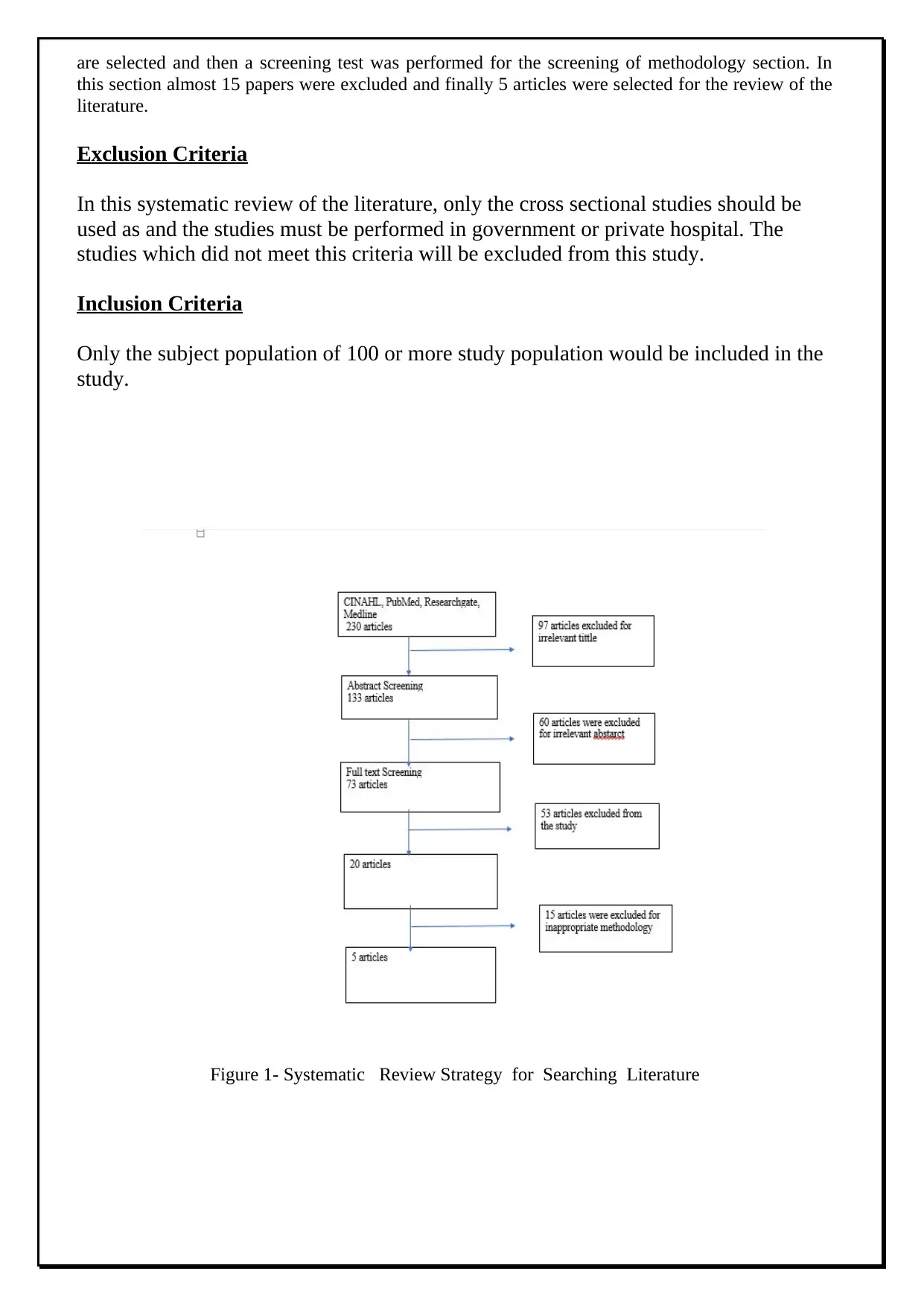
are selected and then a screening test was performed for the screening of methodology section. In
this section almost 15 papers were excluded and finally 5 articles were selected for the review of the
literature.
Exclusion Criteria
In this systematic review of the literature, only the cross sectional studies should be
used as and the studies must be performed in government or private hospital. The
studies which did not meet this criteria will be excluded from this study.
Inclusion Criteria
Only the subject population of 100 or more study population would be included in the
study.
Figure 1- Systematic Review Strategy for Searching Literature
this section almost 15 papers were excluded and finally 5 articles were selected for the review of the
literature.
Exclusion Criteria
In this systematic review of the literature, only the cross sectional studies should be
used as and the studies must be performed in government or private hospital. The
studies which did not meet this criteria will be excluded from this study.
Inclusion Criteria
Only the subject population of 100 or more study population would be included in the
study.
Figure 1- Systematic Review Strategy for Searching Literature
Paraphrase This Document
Need a fresh take? Get an instant paraphrase of this document with our AI Paraphraser
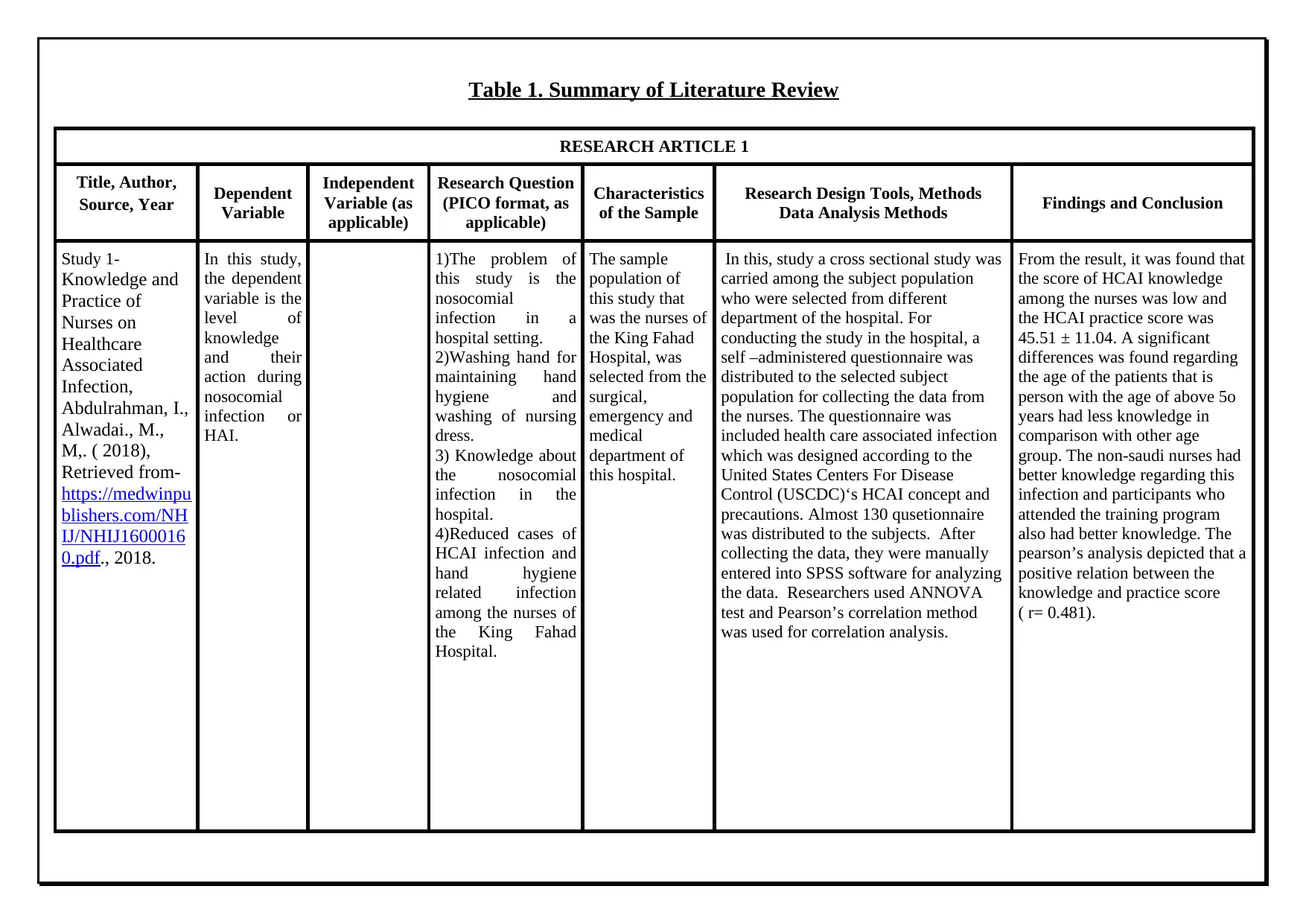
Table 1. Summary of Literature Review
RESEARCH ARTICLE 1
Title, Author,
Source, Year Dependent
Variable
Independent
Variable (as
applicable)
Research Question
(PICO format, as
applicable)
Characteristics
of the Sample
Research Design Tools, Methods
Data Analysis Methods Findings and Conclusion
Study 1-
Knowledge and
Practice of
Nurses on
Healthcare
Associated
Infection,
Abdulrahman, I.,
Alwadai., M.,
M,. ( 2018),
Retrieved from-
https://medwinpu
blishers.com/NH
IJ/NHIJ1600016
0.pdf., 2018.
In this study,
the dependent
variable is the
level of
knowledge
and their
action during
nosocomial
infection or
HAI.
1)The problem of
this study is the
nosocomial
infection in a
hospital setting.
2)Washing hand for
maintaining hand
hygiene and
washing of nursing
dress.
3) Knowledge about
the nosocomial
infection in the
hospital.
4)Reduced cases of
HCAI infection and
hand hygiene
related infection
among the nurses of
the King Fahad
Hospital.
The sample
population of
this study that
was the nurses of
the King Fahad
Hospital, was
selected from the
surgical,
emergency and
medical
department of
this hospital.
In this, study a cross sectional study was
carried among the subject population
who were selected from different
department of the hospital. For
conducting the study in the hospital, a
self –administered questionnaire was
distributed to the selected subject
population for collecting the data from
the nurses. The questionnaire was
included health care associated infection
which was designed according to the
United States Centers For Disease
Control (USCDC)‘s HCAI concept and
precautions. Almost 130 qusetionnaire
was distributed to the subjects. After
collecting the data, they were manually
entered into SPSS software for analyzing
the data. Researchers used ANNOVA
test and Pearson’s correlation method
was used for correlation analysis.
From the result, it was found that
the score of HCAI knowledge
among the nurses was low and
the HCAI practice score was
45.51 ± 11.04. A significant
differences was found regarding
the age of the patients that is
person with the age of above 5o
years had less knowledge in
comparison with other age
group. The non-saudi nurses had
better knowledge regarding this
infection and participants who
attended the training program
also had better knowledge. The
pearson’s analysis depicted that a
positive relation between the
knowledge and practice score
( r= 0.481).
RESEARCH ARTICLE 1
Title, Author,
Source, Year Dependent
Variable
Independent
Variable (as
applicable)
Research Question
(PICO format, as
applicable)
Characteristics
of the Sample
Research Design Tools, Methods
Data Analysis Methods Findings and Conclusion
Study 1-
Knowledge and
Practice of
Nurses on
Healthcare
Associated
Infection,
Abdulrahman, I.,
Alwadai., M.,
M,. ( 2018),
Retrieved from-
https://medwinpu
blishers.com/NH
IJ/NHIJ1600016
0.pdf., 2018.
In this study,
the dependent
variable is the
level of
knowledge
and their
action during
nosocomial
infection or
HAI.
1)The problem of
this study is the
nosocomial
infection in a
hospital setting.
2)Washing hand for
maintaining hand
hygiene and
washing of nursing
dress.
3) Knowledge about
the nosocomial
infection in the
hospital.
4)Reduced cases of
HCAI infection and
hand hygiene
related infection
among the nurses of
the King Fahad
Hospital.
The sample
population of
this study that
was the nurses of
the King Fahad
Hospital, was
selected from the
surgical,
emergency and
medical
department of
this hospital.
In this, study a cross sectional study was
carried among the subject population
who were selected from different
department of the hospital. For
conducting the study in the hospital, a
self –administered questionnaire was
distributed to the selected subject
population for collecting the data from
the nurses. The questionnaire was
included health care associated infection
which was designed according to the
United States Centers For Disease
Control (USCDC)‘s HCAI concept and
precautions. Almost 130 qusetionnaire
was distributed to the subjects. After
collecting the data, they were manually
entered into SPSS software for analyzing
the data. Researchers used ANNOVA
test and Pearson’s correlation method
was used for correlation analysis.
From the result, it was found that
the score of HCAI knowledge
among the nurses was low and
the HCAI practice score was
45.51 ± 11.04. A significant
differences was found regarding
the age of the patients that is
person with the age of above 5o
years had less knowledge in
comparison with other age
group. The non-saudi nurses had
better knowledge regarding this
infection and participants who
attended the training program
also had better knowledge. The
pearson’s analysis depicted that a
positive relation between the
knowledge and practice score
( r= 0.481).
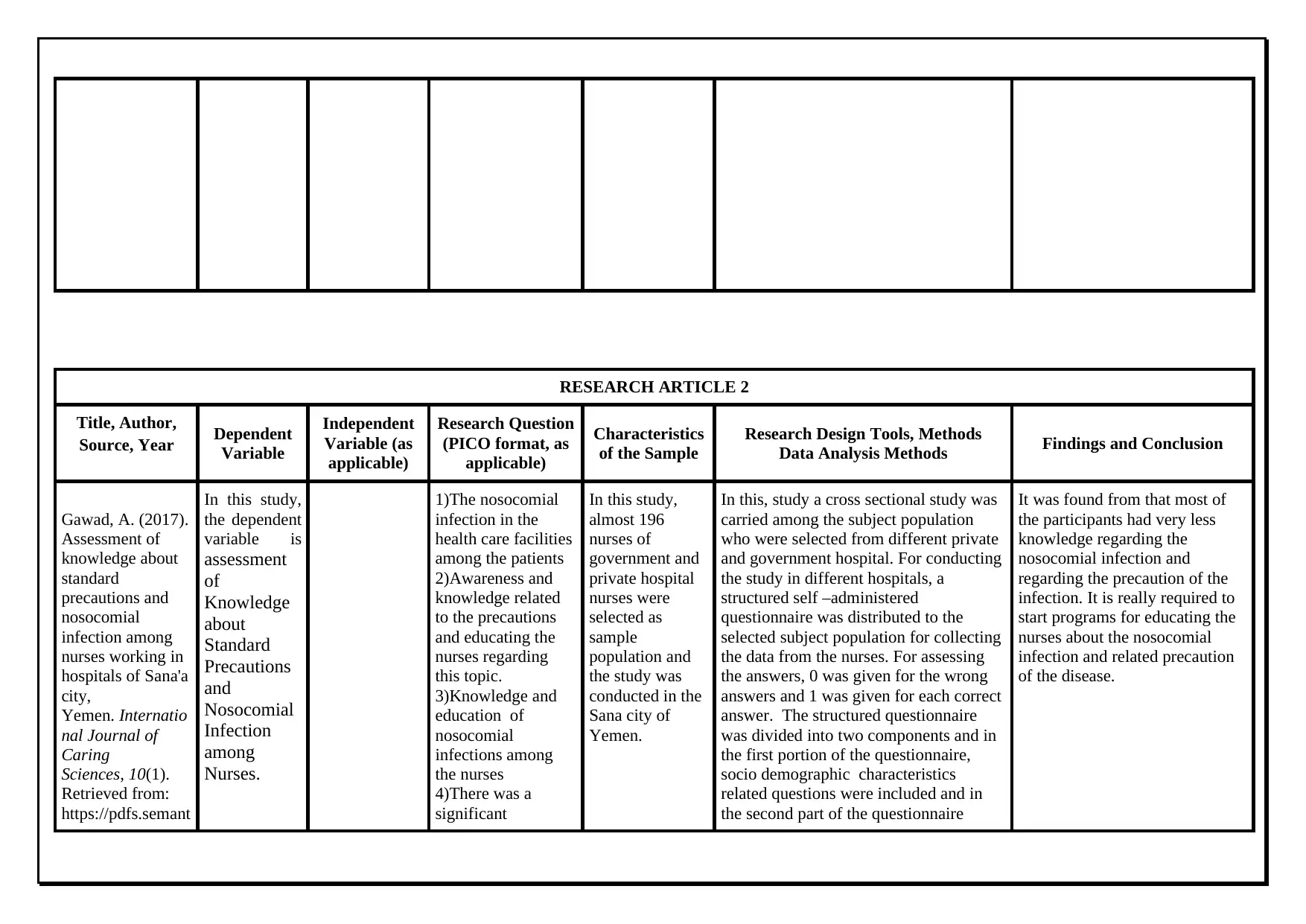
RESEARCH ARTICLE 2
Title, Author,
Source, Year Dependent
Variable
Independent
Variable (as
applicable)
Research Question
(PICO format, as
applicable)
Characteristics
of the Sample
Research Design Tools, Methods
Data Analysis Methods Findings and Conclusion
Gawad, A. (2017).
Assessment of
knowledge about
standard
precautions and
nosocomial
infection among
nurses working in
hospitals of Sana'a
city,
Yemen. Internatio
nal Journal of
Caring
Sciences, 10(1).
Retrieved from:
https://pdfs.semant
In this study,
the dependent
variable is
assessment
of
Knowledge
about
Standard
Precautions
and
Nosocomial
Infection
among
Nurses.
1)The nosocomial
infection in the
health care facilities
among the patients
2)Awareness and
knowledge related
to the precautions
and educating the
nurses regarding
this topic.
3)Knowledge and
education of
nosocomial
infections among
the nurses
4)There was a
significant
In this study,
almost 196
nurses of
government and
private hospital
nurses were
selected as
sample
population and
the study was
conducted in the
Sana city of
Yemen.
In this, study a cross sectional study was
carried among the subject population
who were selected from different private
and government hospital. For conducting
the study in different hospitals, a
structured self –administered
questionnaire was distributed to the
selected subject population for collecting
the data from the nurses. For assessing
the answers, 0 was given for the wrong
answers and 1 was given for each correct
answer. The structured questionnaire
was divided into two components and in
the first portion of the questionnaire,
socio demographic characteristics
related questions were included and in
the second part of the questionnaire
It was found from that most of
the participants had very less
knowledge regarding the
nosocomial infection and
regarding the precaution of the
infection. It is really required to
start programs for educating the
nurses about the nosocomial
infection and related precaution
of the disease.
Title, Author,
Source, Year Dependent
Variable
Independent
Variable (as
applicable)
Research Question
(PICO format, as
applicable)
Characteristics
of the Sample
Research Design Tools, Methods
Data Analysis Methods Findings and Conclusion
Gawad, A. (2017).
Assessment of
knowledge about
standard
precautions and
nosocomial
infection among
nurses working in
hospitals of Sana'a
city,
Yemen. Internatio
nal Journal of
Caring
Sciences, 10(1).
Retrieved from:
https://pdfs.semant
In this study,
the dependent
variable is
assessment
of
Knowledge
about
Standard
Precautions
and
Nosocomial
Infection
among
Nurses.
1)The nosocomial
infection in the
health care facilities
among the patients
2)Awareness and
knowledge related
to the precautions
and educating the
nurses regarding
this topic.
3)Knowledge and
education of
nosocomial
infections among
the nurses
4)There was a
significant
In this study,
almost 196
nurses of
government and
private hospital
nurses were
selected as
sample
population and
the study was
conducted in the
Sana city of
Yemen.
In this, study a cross sectional study was
carried among the subject population
who were selected from different private
and government hospital. For conducting
the study in different hospitals, a
structured self –administered
questionnaire was distributed to the
selected subject population for collecting
the data from the nurses. For assessing
the answers, 0 was given for the wrong
answers and 1 was given for each correct
answer. The structured questionnaire
was divided into two components and in
the first portion of the questionnaire,
socio demographic characteristics
related questions were included and in
the second part of the questionnaire
It was found from that most of
the participants had very less
knowledge regarding the
nosocomial infection and
regarding the precaution of the
infection. It is really required to
start programs for educating the
nurses about the nosocomial
infection and related precaution
of the disease.
⊘ This is a preview!⊘
Do you want full access?
Subscribe today to unlock all pages.

Trusted by 1+ million students worldwide
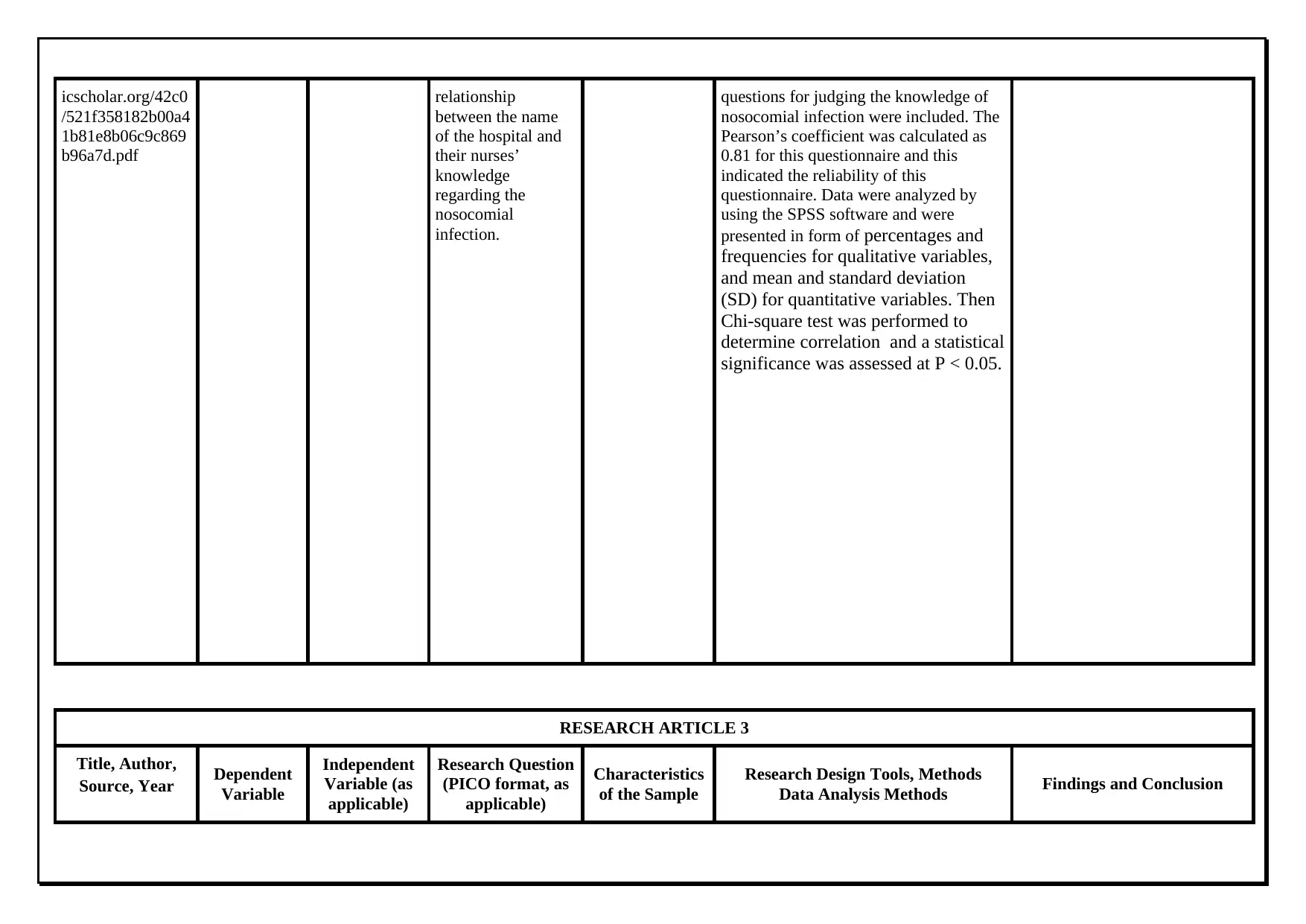
icscholar.org/42c0
/521f358182b00a4
1b81e8b06c9c869
b96a7d.pdf
relationship
between the name
of the hospital and
their nurses’
knowledge
regarding the
nosocomial
infection.
questions for judging the knowledge of
nosocomial infection were included. The
Pearson’s coefficient was calculated as
0.81 for this questionnaire and this
indicated the reliability of this
questionnaire. Data were analyzed by
using the SPSS software and were
presented in form of percentages and
frequencies for qualitative variables,
and mean and standard deviation
(SD) for quantitative variables. Then
Chi-square test was performed to
determine correlation and a statistical
significance was assessed at P < 0.05.
RESEARCH ARTICLE 3
Title, Author,
Source, Year Dependent
Variable
Independent
Variable (as
applicable)
Research Question
(PICO format, as
applicable)
Characteristics
of the Sample
Research Design Tools, Methods
Data Analysis Methods Findings and Conclusion
/521f358182b00a4
1b81e8b06c9c869
b96a7d.pdf
relationship
between the name
of the hospital and
their nurses’
knowledge
regarding the
nosocomial
infection.
questions for judging the knowledge of
nosocomial infection were included. The
Pearson’s coefficient was calculated as
0.81 for this questionnaire and this
indicated the reliability of this
questionnaire. Data were analyzed by
using the SPSS software and were
presented in form of percentages and
frequencies for qualitative variables,
and mean and standard deviation
(SD) for quantitative variables. Then
Chi-square test was performed to
determine correlation and a statistical
significance was assessed at P < 0.05.
RESEARCH ARTICLE 3
Title, Author,
Source, Year Dependent
Variable
Independent
Variable (as
applicable)
Research Question
(PICO format, as
applicable)
Characteristics
of the Sample
Research Design Tools, Methods
Data Analysis Methods Findings and Conclusion
Paraphrase This Document
Need a fresh take? Get an instant paraphrase of this document with our AI Paraphraser
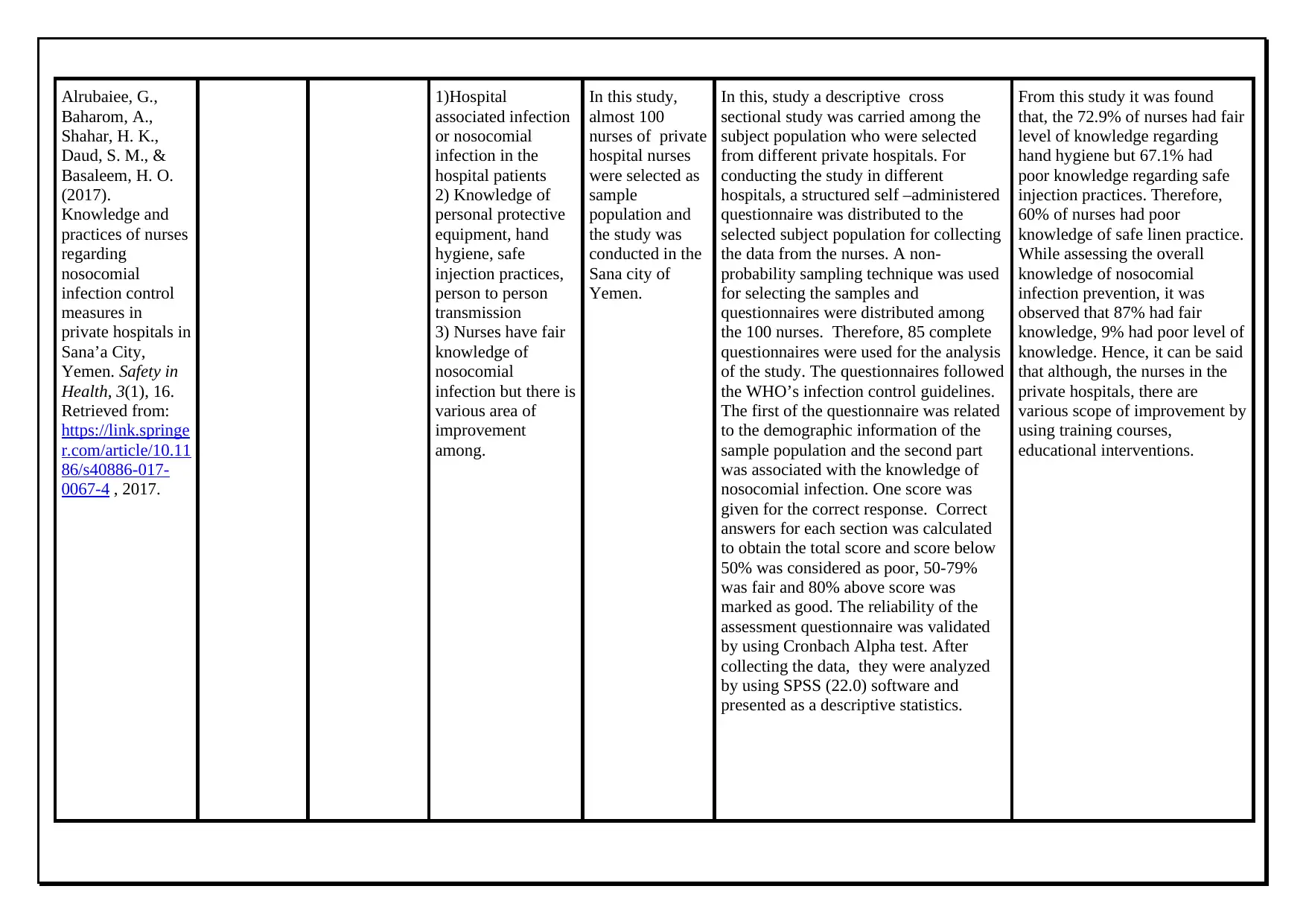
Alrubaiee, G.,
Baharom, A.,
Shahar, H. K.,
Daud, S. M., &
Basaleem, H. O.
(2017).
Knowledge and
practices of nurses
regarding
nosocomial
infection control
measures in
private hospitals in
Sana’a City,
Yemen. Safety in
Health, 3(1), 16.
Retrieved from:
https://link.springe
r.com/article/10.11
86/s40886-017-
0067-4 , 2017.
1)Hospital
associated infection
or nosocomial
infection in the
hospital patients
2) Knowledge of
personal protective
equipment, hand
hygiene, safe
injection practices,
person to person
transmission
3) Nurses have fair
knowledge of
nosocomial
infection but there is
various area of
improvement
among.
In this study,
almost 100
nurses of private
hospital nurses
were selected as
sample
population and
the study was
conducted in the
Sana city of
Yemen.
In this, study a descriptive cross
sectional study was carried among the
subject population who were selected
from different private hospitals. For
conducting the study in different
hospitals, a structured self –administered
questionnaire was distributed to the
selected subject population for collecting
the data from the nurses. A non-
probability sampling technique was used
for selecting the samples and
questionnaires were distributed among
the 100 nurses. Therefore, 85 complete
questionnaires were used for the analysis
of the study. The questionnaires followed
the WHO’s infection control guidelines.
The first of the questionnaire was related
to the demographic information of the
sample population and the second part
was associated with the knowledge of
nosocomial infection. One score was
given for the correct response. Correct
answers for each section was calculated
to obtain the total score and score below
50% was considered as poor, 50-79%
was fair and 80% above score was
marked as good. The reliability of the
assessment questionnaire was validated
by using Cronbach Alpha test. After
collecting the data, they were analyzed
by using SPSS (22.0) software and
presented as a descriptive statistics.
From this study it was found
that, the 72.9% of nurses had fair
level of knowledge regarding
hand hygiene but 67.1% had
poor knowledge regarding safe
injection practices. Therefore,
60% of nurses had poor
knowledge of safe linen practice.
While assessing the overall
knowledge of nosocomial
infection prevention, it was
observed that 87% had fair
knowledge, 9% had poor level of
knowledge. Hence, it can be said
that although, the nurses in the
private hospitals, there are
various scope of improvement by
using training courses,
educational interventions.
Baharom, A.,
Shahar, H. K.,
Daud, S. M., &
Basaleem, H. O.
(2017).
Knowledge and
practices of nurses
regarding
nosocomial
infection control
measures in
private hospitals in
Sana’a City,
Yemen. Safety in
Health, 3(1), 16.
Retrieved from:
https://link.springe
r.com/article/10.11
86/s40886-017-
0067-4 , 2017.
1)Hospital
associated infection
or nosocomial
infection in the
hospital patients
2) Knowledge of
personal protective
equipment, hand
hygiene, safe
injection practices,
person to person
transmission
3) Nurses have fair
knowledge of
nosocomial
infection but there is
various area of
improvement
among.
In this study,
almost 100
nurses of private
hospital nurses
were selected as
sample
population and
the study was
conducted in the
Sana city of
Yemen.
In this, study a descriptive cross
sectional study was carried among the
subject population who were selected
from different private hospitals. For
conducting the study in different
hospitals, a structured self –administered
questionnaire was distributed to the
selected subject population for collecting
the data from the nurses. A non-
probability sampling technique was used
for selecting the samples and
questionnaires were distributed among
the 100 nurses. Therefore, 85 complete
questionnaires were used for the analysis
of the study. The questionnaires followed
the WHO’s infection control guidelines.
The first of the questionnaire was related
to the demographic information of the
sample population and the second part
was associated with the knowledge of
nosocomial infection. One score was
given for the correct response. Correct
answers for each section was calculated
to obtain the total score and score below
50% was considered as poor, 50-79%
was fair and 80% above score was
marked as good. The reliability of the
assessment questionnaire was validated
by using Cronbach Alpha test. After
collecting the data, they were analyzed
by using SPSS (22.0) software and
presented as a descriptive statistics.
From this study it was found
that, the 72.9% of nurses had fair
level of knowledge regarding
hand hygiene but 67.1% had
poor knowledge regarding safe
injection practices. Therefore,
60% of nurses had poor
knowledge of safe linen practice.
While assessing the overall
knowledge of nosocomial
infection prevention, it was
observed that 87% had fair
knowledge, 9% had poor level of
knowledge. Hence, it can be said
that although, the nurses in the
private hospitals, there are
various scope of improvement by
using training courses,
educational interventions.

RESEARCH ARTICLE 4
Title, Author,
Source, Year Dependent
Variable
Independent
Variable (as
applicable)
Research Question
(PICO format, as
applicable)
Characteristics
of the Sample
Research Design Tools, Methods
Data Analysis Methods Findings and Conclusion
Al Ra’awji, B. A.,
Almogbel, E. S.,
Alharbi, L. A.,
Alotaibi, A. K.,
Al-Qazlan, F. A.,
& Saquib, J.
(2018).
Knowledge,
attitudes, and
practices of
health-care
workers regarding
hand hygiene
guidelines in Al-
Qassim, Saudi
Arabia: A
multicenter
study. Internation
al journal of
health
Knowledge
and practices
of health care
workers
regarding
hand hygiene
related to the
nosocomial
infection
1)lack of knowledge
regarding
association of hand
hygiene practice and
nosocomial
infection in the
hospital of Saudi
Arabia
2) Using alcohol,
soap and water for
maintain hand
hygiene
3) The comparison
can be done
regarding use of
different agents for
hand washing such
as only water,
alcohol,
combination of
water and soap and
Almost 345
respondents were
included in this
study.
In this, study a cross sectional study was
carried among the subject population
who were selected from different
government hospitals such as Al Rass
General Hospital (AGH), ) King Fahad
Specialized Hospital (KFSH) which
is a tertiary center , Buraidah Central
Hospital (BCH). All these centers are
located in the Al-Qassim in Saudi
Arabia. The data collection method
was conducted for 3 months. A self-
administered questionnaire was used
for this study. The questionnaire was
comprised of 25 questions related to
the knowledge, 5 questions related to
the attitude towards an adverse
infection condition, and remaining 5
for the practices of maintaining hand
hygiene. After collecting the data, all
the data were assessed. Each correct
The primary finding of that study
was that the knowledge
regarding relation of hand
hygiene and nosocomial
infection was very poor among
the chosen subject population.
The overall score showed that,
the health care workers had lack
of knowledge. Along with this,
significant differences was noted
among the younger nurses and
older nurses aged more than 30
years. Moreover, in some cases it
was found that, the wrong
knowledge regarding hand
hygiene practice was responsible
for the low score. Significant
difference was noted among the
staffs of tertiary and secondary
staff nurses and the later had
more number of knowledgeable
Title, Author,
Source, Year Dependent
Variable
Independent
Variable (as
applicable)
Research Question
(PICO format, as
applicable)
Characteristics
of the Sample
Research Design Tools, Methods
Data Analysis Methods Findings and Conclusion
Al Ra’awji, B. A.,
Almogbel, E. S.,
Alharbi, L. A.,
Alotaibi, A. K.,
Al-Qazlan, F. A.,
& Saquib, J.
(2018).
Knowledge,
attitudes, and
practices of
health-care
workers regarding
hand hygiene
guidelines in Al-
Qassim, Saudi
Arabia: A
multicenter
study. Internation
al journal of
health
Knowledge
and practices
of health care
workers
regarding
hand hygiene
related to the
nosocomial
infection
1)lack of knowledge
regarding
association of hand
hygiene practice and
nosocomial
infection in the
hospital of Saudi
Arabia
2) Using alcohol,
soap and water for
maintain hand
hygiene
3) The comparison
can be done
regarding use of
different agents for
hand washing such
as only water,
alcohol,
combination of
water and soap and
Almost 345
respondents were
included in this
study.
In this, study a cross sectional study was
carried among the subject population
who were selected from different
government hospitals such as Al Rass
General Hospital (AGH), ) King Fahad
Specialized Hospital (KFSH) which
is a tertiary center , Buraidah Central
Hospital (BCH). All these centers are
located in the Al-Qassim in Saudi
Arabia. The data collection method
was conducted for 3 months. A self-
administered questionnaire was used
for this study. The questionnaire was
comprised of 25 questions related to
the knowledge, 5 questions related to
the attitude towards an adverse
infection condition, and remaining 5
for the practices of maintaining hand
hygiene. After collecting the data, all
the data were assessed. Each correct
The primary finding of that study
was that the knowledge
regarding relation of hand
hygiene and nosocomial
infection was very poor among
the chosen subject population.
The overall score showed that,
the health care workers had lack
of knowledge. Along with this,
significant differences was noted
among the younger nurses and
older nurses aged more than 30
years. Moreover, in some cases it
was found that, the wrong
knowledge regarding hand
hygiene practice was responsible
for the low score. Significant
difference was noted among the
staffs of tertiary and secondary
staff nurses and the later had
more number of knowledgeable
⊘ This is a preview!⊘
Do you want full access?
Subscribe today to unlock all pages.

Trusted by 1+ million students worldwide

sciences, 12(2), 3.
Retrieved from:
https://www.ncbi.
nlm.nih.gov/pmc/a
rticles/PMC58703
28/ (2018)
other method
4)Significant
difference was
noted while
comparing nurses of
different hospitals.
response was marked as 1 point and
the score was converted to a
percentage value. After this scoring
method, an one way ANOVA was
performed in order to analyze any
correlation between the knowledge
score and demographic characteristics
of the nurses such as gender, age,
organization. The data were
performed by using the SPSS
software version 21.
staffs than the former one. The
another finding of this study was
that, the health workers had
positive views regarding the
hand hygiene practice. The
authors had concluded that, there
were a various gap in knowledge
and those can be overcome by
using frequent training sessions
for the staff nurses, physicians in
the hospitals specifically
secondary hospitals of Saudi
Arabia.
Retrieved from:
https://www.ncbi.
nlm.nih.gov/pmc/a
rticles/PMC58703
28/ (2018)
other method
4)Significant
difference was
noted while
comparing nurses of
different hospitals.
response was marked as 1 point and
the score was converted to a
percentage value. After this scoring
method, an one way ANOVA was
performed in order to analyze any
correlation between the knowledge
score and demographic characteristics
of the nurses such as gender, age,
organization. The data were
performed by using the SPSS
software version 21.
staffs than the former one. The
another finding of this study was
that, the health workers had
positive views regarding the
hand hygiene practice. The
authors had concluded that, there
were a various gap in knowledge
and those can be overcome by
using frequent training sessions
for the staff nurses, physicians in
the hospitals specifically
secondary hospitals of Saudi
Arabia.
Paraphrase This Document
Need a fresh take? Get an instant paraphrase of this document with our AI Paraphraser
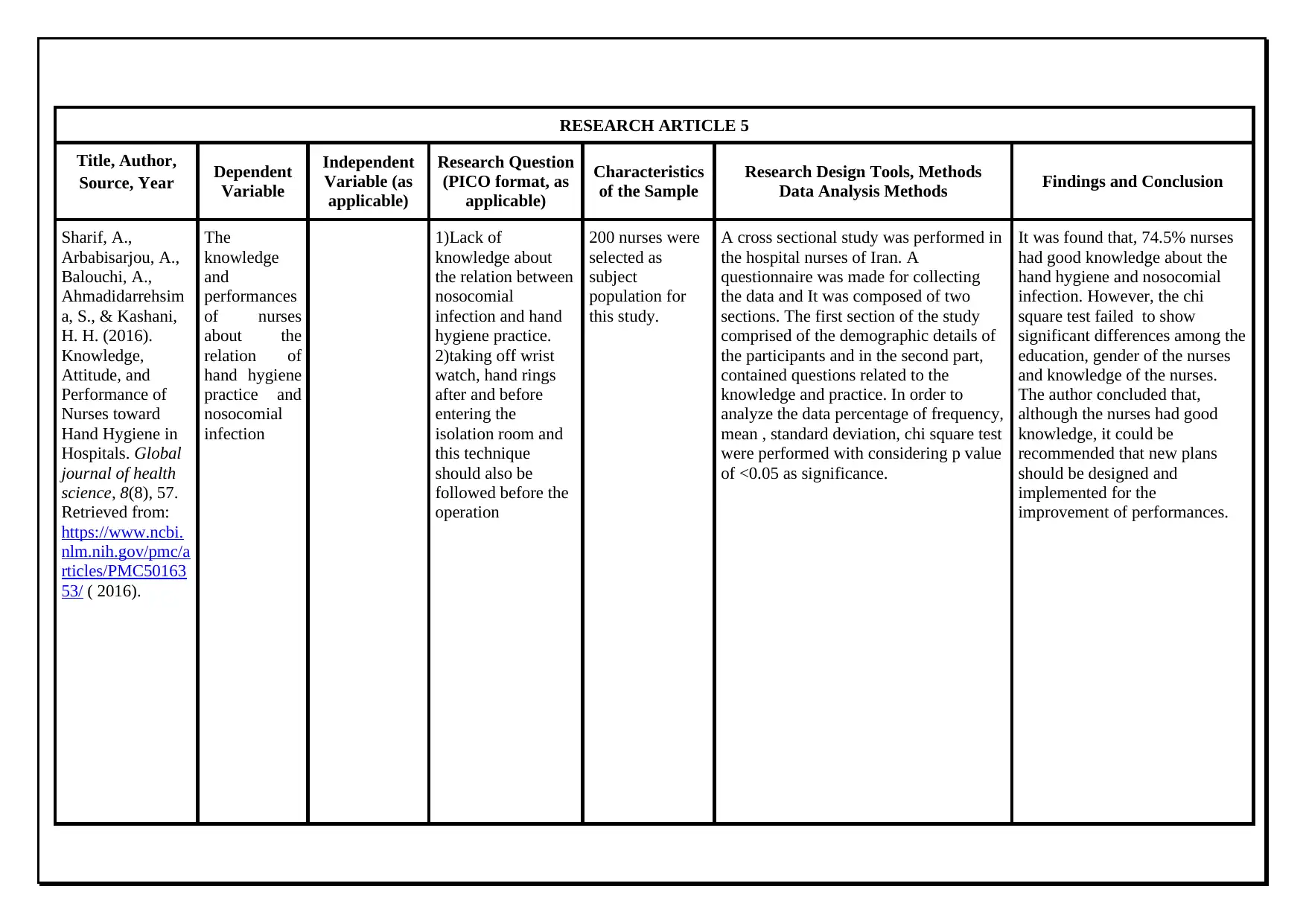
RESEARCH ARTICLE 5
Title, Author,
Source, Year Dependent
Variable
Independent
Variable (as
applicable)
Research Question
(PICO format, as
applicable)
Characteristics
of the Sample
Research Design Tools, Methods
Data Analysis Methods Findings and Conclusion
Sharif, A.,
Arbabisarjou, A.,
Balouchi, A.,
Ahmadidarrehsim
a, S., & Kashani,
H. H. (2016).
Knowledge,
Attitude, and
Performance of
Nurses toward
Hand Hygiene in
Hospitals. Global
journal of health
science, 8(8), 57.
Retrieved from:
https://www.ncbi.
nlm.nih.gov/pmc/a
rticles/PMC50163
53/ ( 2016).
The
knowledge
and
performances
of nurses
about the
relation of
hand hygiene
practice and
nosocomial
infection
1)Lack of
knowledge about
the relation between
nosocomial
infection and hand
hygiene practice.
2)taking off wrist
watch, hand rings
after and before
entering the
isolation room and
this technique
should also be
followed before the
operation
200 nurses were
selected as
subject
population for
this study.
A cross sectional study was performed in
the hospital nurses of Iran. A
questionnaire was made for collecting
the data and It was composed of two
sections. The first section of the study
comprised of the demographic details of
the participants and in the second part,
contained questions related to the
knowledge and practice. In order to
analyze the data percentage of frequency,
mean , standard deviation, chi square test
were performed with considering p value
of <0.05 as significance.
It was found that, 74.5% nurses
had good knowledge about the
hand hygiene and nosocomial
infection. However, the chi
square test failed to show
significant differences among the
education, gender of the nurses
and knowledge of the nurses.
The author concluded that,
although the nurses had good
knowledge, it could be
recommended that new plans
should be designed and
implemented for the
improvement of performances.
Title, Author,
Source, Year Dependent
Variable
Independent
Variable (as
applicable)
Research Question
(PICO format, as
applicable)
Characteristics
of the Sample
Research Design Tools, Methods
Data Analysis Methods Findings and Conclusion
Sharif, A.,
Arbabisarjou, A.,
Balouchi, A.,
Ahmadidarrehsim
a, S., & Kashani,
H. H. (2016).
Knowledge,
Attitude, and
Performance of
Nurses toward
Hand Hygiene in
Hospitals. Global
journal of health
science, 8(8), 57.
Retrieved from:
https://www.ncbi.
nlm.nih.gov/pmc/a
rticles/PMC50163
53/ ( 2016).
The
knowledge
and
performances
of nurses
about the
relation of
hand hygiene
practice and
nosocomial
infection
1)Lack of
knowledge about
the relation between
nosocomial
infection and hand
hygiene practice.
2)taking off wrist
watch, hand rings
after and before
entering the
isolation room and
this technique
should also be
followed before the
operation
200 nurses were
selected as
subject
population for
this study.
A cross sectional study was performed in
the hospital nurses of Iran. A
questionnaire was made for collecting
the data and It was composed of two
sections. The first section of the study
comprised of the demographic details of
the participants and in the second part,
contained questions related to the
knowledge and practice. In order to
analyze the data percentage of frequency,
mean , standard deviation, chi square test
were performed with considering p value
of <0.05 as significance.
It was found that, 74.5% nurses
had good knowledge about the
hand hygiene and nosocomial
infection. However, the chi
square test failed to show
significant differences among the
education, gender of the nurses
and knowledge of the nurses.
The author concluded that,
although the nurses had good
knowledge, it could be
recommended that new plans
should be designed and
implemented for the
improvement of performances.
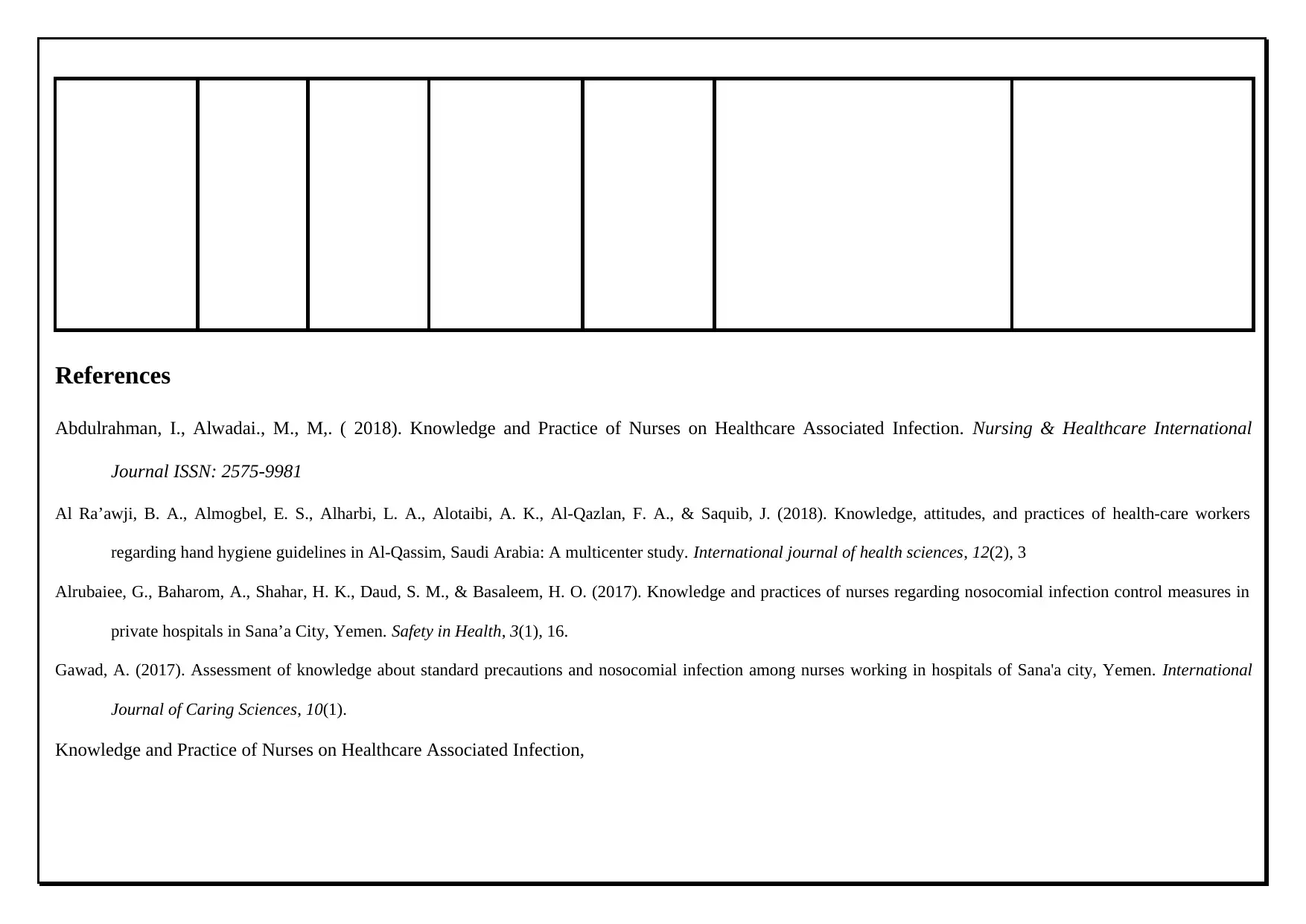
References
Abdulrahman, I., Alwadai., M., M,. ( 2018). Knowledge and Practice of Nurses on Healthcare Associated Infection. Nursing & Healthcare International
Journal ISSN: 2575-9981
Al Ra’awji, B. A., Almogbel, E. S., Alharbi, L. A., Alotaibi, A. K., Al-Qazlan, F. A., & Saquib, J. (2018). Knowledge, attitudes, and practices of health-care workers
regarding hand hygiene guidelines in Al-Qassim, Saudi Arabia: A multicenter study. International journal of health sciences, 12(2), 3
Alrubaiee, G., Baharom, A., Shahar, H. K., Daud, S. M., & Basaleem, H. O. (2017). Knowledge and practices of nurses regarding nosocomial infection control measures in
private hospitals in Sana’a City, Yemen. Safety in Health, 3(1), 16.
Gawad, A. (2017). Assessment of knowledge about standard precautions and nosocomial infection among nurses working in hospitals of Sana'a city, Yemen. International
Journal of Caring Sciences, 10(1).
Knowledge and Practice of Nurses on Healthcare Associated Infection,
Abdulrahman, I., Alwadai., M., M,. ( 2018). Knowledge and Practice of Nurses on Healthcare Associated Infection. Nursing & Healthcare International
Journal ISSN: 2575-9981
Al Ra’awji, B. A., Almogbel, E. S., Alharbi, L. A., Alotaibi, A. K., Al-Qazlan, F. A., & Saquib, J. (2018). Knowledge, attitudes, and practices of health-care workers
regarding hand hygiene guidelines in Al-Qassim, Saudi Arabia: A multicenter study. International journal of health sciences, 12(2), 3
Alrubaiee, G., Baharom, A., Shahar, H. K., Daud, S. M., & Basaleem, H. O. (2017). Knowledge and practices of nurses regarding nosocomial infection control measures in
private hospitals in Sana’a City, Yemen. Safety in Health, 3(1), 16.
Gawad, A. (2017). Assessment of knowledge about standard precautions and nosocomial infection among nurses working in hospitals of Sana'a city, Yemen. International
Journal of Caring Sciences, 10(1).
Knowledge and Practice of Nurses on Healthcare Associated Infection,
⊘ This is a preview!⊘
Do you want full access?
Subscribe today to unlock all pages.

Trusted by 1+ million students worldwide
1 out of 13
Related Documents
Your All-in-One AI-Powered Toolkit for Academic Success.
+13062052269
info@desklib.com
Available 24*7 on WhatsApp / Email
![[object Object]](/_next/static/media/star-bottom.7253800d.svg)
Unlock your academic potential
Copyright © 2020–2026 A2Z Services. All Rights Reserved. Developed and managed by ZUCOL.




